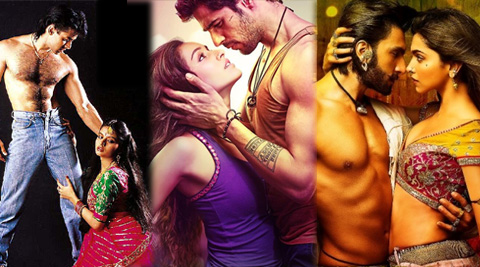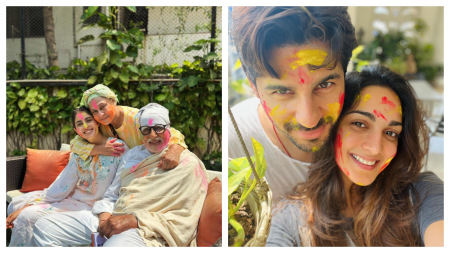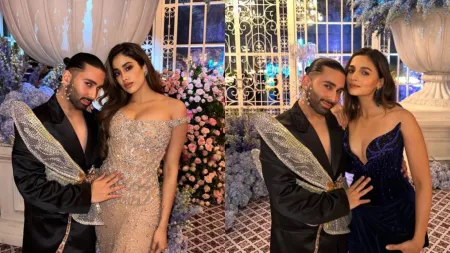- India
- International
How Deep is Their Love?
From Salman Khan to Sidharth Malhotra, the man in love in Hindi cinema has come some distance but hasn’t grown up.
 From Salman Khan to Sidharth Malhotra, the man in love in Hindi cinema has come some distance but hasn’t grown up.
From Salman Khan to Sidharth Malhotra, the man in love in Hindi cinema has come some distance but hasn’t grown up.
From sanskari to sexing the cherry, Salman Khan to Sidharth Malhotra, the man in love in Hindi cinema has come some distance. But he still hasn’t grown up.
Kisise bhi pooch lo, report achchi milegi.
The report in question has nothing to do with scholastic prowess. Ranveer Singh, Bollywood hero, is regaling a room full of men, and the comment leads to ribald laughter. He’s talking about the thing that men and women do when lust overpowers caution. He is all man, he is saying, and it’s his bounden duty to keep his lady loves happy. Because that’s what real men do.
Goliyon Ki Rasleela Ram-Leela, the film in which Singh throws away this line with a leer, gives us a pair of lovers with serious sizzle. The heroine is slim and supple and lovely. But it’s the hero who is presented as the ultimate sex object, chest oiled to a dazzling degree, red gamchha pointing towards his mobile pelvis. He’s ready for it, if you are.
Ranveer’s carefully cultivated too-cool-for-school air has led him to roles bursting with raunch. His recent leap to a condom advertisement looks as if it was the logical step up for his blatant Durex appeal in Ram Leela. The advert, if you haven’t seen it, is about, well, sex. Not the sort which emphasizes all-clothes-on, leading-strictly-to-reproduction “respectable” coupling. But between men and women, who are up for it because they want to.
A leading man as the orgasmic face of a condom ? Doing it and reveling in it ? Whoa. Is Bollywood all grown up finally? Are its men, hallelujah, men, and not lily-livered boys, hiding behind the Pathan suits, and Paithani sarees, of their parents? Is their loving — and living — in keeping with the times?

I wish I could say an uncomplicated yes. But India-that-is-Bharat encourages unquestioning worship of tradition. Its grasp on modernity has been, at best, slippery and problematic. To keep it simple, sanctified love, ordained by the stars and elders who were automatically betters, is what India, and Hindi cinema did best, for a long, long time.
What can you say about a country with people who declare, without a shred of irony, “Oh, I had an ‘arranged love’ marriage”? Love without familial approval was long forbidden, so you were free to fall in love with your spouse after the fact. I’m not for a moment suggesting that that’s not possible, but that graven-in-stone decree gave us decades of infantilised girls and boys in the movies. And at the movies.
It was Amitabh Bachchan who broke the mould, redefining The Hero: he could kill, he could maim, he could get drunk, he could, gasp, bed a woman out of wedlock, and enjoy it. Hindi cinema’s leap from the virginal hero and heroine coming together via mandap and mangalsutra to the brooding hero who could smoke a post-coital cigarette with a good-time woman, was cataclysmic.
Bachchan could have left Bollywood to grapple with this new order, and reach a place where there would be no need for callow boys and girls anymore. But we were not ready for it. He aged, his box office sway diminished. The film industry, groaning under the double impact of its fading superstar and the onslaught of piracy, made another giant jump. But this time, it was backwards.
Qayamat Se Qayamat Tak heralded the arrival of sparkling new stars, and the treatment was fresh, but the story of warring Thakurs and gharane ki izzat and doomed young love was old. We embraced the fresh-faced Aamir Khan, who had to sing Papa kehte hain bada naam karega, before he was allowed to fall for the perky Juhi Chawla. Love is back, carolled Bollywood.
Thing is, it was not really Love. It was the Family Drama which had died a temporary death in the 1980s. QSQT came along in ’88, and resurrected the creaky tropes that could safely house young lovers. Along came Salman Khan and the House of Barjatyas , the prime upholders of family honour and Bharatiya sanskriti, and gave us, in short order, Maine Pyar Kiya (’89), and Hum Aapke Hain Koun…! (which celebrates its 20th anniversary next month).
Salman’s spectacular success cemented the notion of the ideal young lover. He was the laadla beta , and the respectful chota bhai, before he was a lover, and that was always what it was going to be like. India-Bharat and its nostalgic for the good-ol’-country NRIs rejoiced: this is how things are, and this is how they should be.
There’s a great deal of physical proximity and playfulness between Salman and Madhuri in Hum Aapke Hain Koun, but it was contained in the living room and the kitchen. Under Sooraj Barjatya’s sanitised baton, their awareness of each other 20 years back is as much in evidence as Ranveer and Deepika’s in Goliyon
Ki Rasleela, but the sexual tension is kept to a minimum, covering it with the banter between bhaiya and bhabhi, jiji and jijaji, not to forget Tuffy the Pomeranian. Maine Pyar Kiya uses a pigeon to show the flow of feeling between the Shirtless Salman and the insufferably coy Bhagyashree, but its arc is set by the two sets of battling fathers, with the women sniffling on the side.
We would have drowned in saccharine in the early 1990s if it hadn’t been for Shah Rukh Khan. In a smart move, he became the Manic Lover, who could ruthlessly push the girls he professed to love off high terraces, or make sure they were imprisoned and tortured, in order to get where he wanted. Baazigar, Darr and Anjaam seem almost like a well-planned trilogy, where SRK breaks every rule in the young Bollywood lover book. One of my favourite SRK parts is his playing of the damaged hero in the near-forgotten Ram Jaane, who nearly jumps his girl’s (Juhi Chawla) bones: he wants it so bad, he can’t hide it.
But the lover who can bleed, and shed blood in turn was buried good and proper by the definitive SRK turn in Dilwale Dulhaniya Le Jayenge. He flirts with Kajol, channelling his inner brat, but becomes all susheel and sanskari when it really comes down to it. Only when her father gives his aashirwaad, does he take his dulhaniya away.
Bollywood has never recovered from the DDLJ whammy. Every time there’s a new hero, he is made to do a DDLJ version: even SRK went into redux mode in last year’s Chennai Express. Meanwhile, for those who were tired of zardozi-clad dulhas and dulhans, there was Aamir Khan who kissed his leading lady — mouth, lips and all— in Raja Hindustani. And Saif Ali Khan, who went all the way.
Saif conquered the real rom-com space with Hum Tum and a little help from Hollywood. His romance with Rani has nary a mother, father, or a child, or a fluffy animal in tow. This is between a man and a woman. He wore red undies in Salaam Namaste, got it on with Preity Zinta, and, oops, knocked her up. Was THIS going to be the turning point?
Fat chance. In the way India that is Bharat takes two steps forward, three back, mainstream Bollywood keeps returning to its old ways. The ratio between boys and men is still abysmal. Of the brave new Bollywood crop, Ranbir Kapoor has done a wonderful job of being both, and sometimes in the same film (Yeh Jawaani Hai Deewani), because as audiences, we still seem to demand that boys should first be boys, before they can be men.
Emran Hashmi has smooched his way ahead. He’s not afraid of the possibility of sex. He actively seeks it, and has found a fan base which wants to see him do more. Ranbir has a clear inclination towards manliness, because he is not scared of grown-up roles. Ranveer is doing his bit. So is Arjun Kapoor. But they are all struggling with stereotypes — The Loser, The Bad Boy, The Rebel, The Serial Kisser.
I am waiting for the time when the hero, and by extension, the heroine, can break free from these strictures. Because real men, and women, and real love with combinations thereof, need none. There was a glimmer of hope in a recent film, Hansee Toh Phansee, which I didn’t like as much as I could have because its heroine was a label. Parineeti Chopra could have been a free-spirited freako, and a great Bollywood heroine. Instead she is the Jhalli Who Makes Faces. But, but. The hero made me pause. Sidharth Malhotra is that most rare thing in Bollywood. He is not a cliché.
He is just a guy, who falls in love. Time to make the leap that really needs to be taken. To man up.
Click for more updates and latest Bollywood news along with Entertainment updates. Also get latest news and top headlines from India and around the world at The Indian Express.
Photos
Apr 19: Latest News
- 01
- 02
- 03
- 04
- 05








































